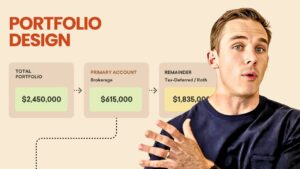How to Shift Your Portfolio Before Retirement Without Losing Sleep

When you’re closing in on retirement, one of the most important decisions you’ll make isn’t when to retire—it’s how to adjust your investment portfolio to make that transition as smooth (and secure) as possible. Mistiming this shift can mean missing out on gains or worse, being exposed to a market downturn that could derail your plans entirely.
So how do you find that perfect balance between growth and stability?
1. Why Timing Your Portfolio Shift Matters
If you adjust too early, you risk giving up crucial growth. Adjust too late, and you might face significant losses if the market drops just before or after you retire. The right timing isn’t based solely on your retirement date—it’s based on when you’ll actually need to tap into those funds.
That distinction is key.
If you plan to retire in ten years but won’t need to draw from your portfolio for 15 years, your investment strategy should reflect that 15-year timeline.
2. The Power (and Predictability) of Long-Term Investing
Markets can feel unpredictable—because in the short term, they are. But history provides some helpful guideposts. According to historical S&P 500 data:
- It has positive daily returns 53% of the time,
- Monthly 63%,
- Annually 73%,
- Over 5 years: 88% of the time,
- And over 10 years: 94%.
Over any 20-year rolling period? There hasn’t been a negative outcome.
That’s why staying invested in stocks over longer periods generally produces reliable growth. It’s about trading short-term uncertainty for long-term confidence.
3. Bonds: Not Just About Returns, But About Peace of Mind
Adding bonds to your portfolio doesn’t just reduce volatility—it can also help you sleep better at night. Bonds provide stability and act as a buffer when stocks are down, allowing you to avoid selling at a loss during tough market periods.
They also serve different purposes:
- Liability matching (e.g., covering known future expenses),
- Emergency reserve (in case of unexpected expenses),
- Psychological reassurance, helping investors stay disciplined during volatility.
Even if your portfolio mathematically doesn’t require bonds, emotionally, you might.
4. Let Your Income Needs Drive Allocation—Not Just Your Age
Your portfolio size and income requirements should dictate your stock-to-bond allocation. For example:
- If you have a $1 million portfolio and need $40,000 per year, a 60/40 stock-to-bond mix might make sense.
- But if your portfolio is $4 million, you might only need a 90/10 allocation to generate the same income.
At a 2% dividend yield, a $4 million portfolio can provide $80,000 per year—double what’s needed in this scenario—without selling a single share.
5. Start the Shift Early, but Move Gradually
Experts recommend beginning the conversation about adjusting your portfolio about ten years before retirement, with more significant changes starting around the five-year mark.
Rather than making a drastic shift, consider:
- Reinvesting dividends into conservative assets,
- Redirecting new contributions toward bonds,
- Shifting a small percentage—say, 4%—from stocks to bonds annually.
This allows your portfolio to evolve without shocking your long-term growth.
6. Don’t Let Fear Drive the Bus
While it’s tempting to go ultra-conservative near retirement, playing it too safe can be just as dangerous as being too aggressive. If your returns don’t outpace inflation, you risk running out of money—or missing out on the retirement you’ve worked so hard to earn.
That’s why successful retirement planning is as much about managing your emotions as your money. Your portfolio should be built not just to survive volatility—but to help you stay confident no matter what the markets do.
You should always consult a financial, tax, or legal professional familiar about your unique circumstances before making any financial decisions. This material is intended for educational purposes only. Nothing in this material constitutes a solicitation for the sale or purchase of any securities. Any mentioned rates of return are historical or hypothetical in nature and are not a guarantee of future returns.
Past performance does not guarantee future performance. Future returns may be lower or higher. Investments involve risk. Investment values will fluctuate with market conditions, and security positions, when sold, may be worth less or more than their original cost.







